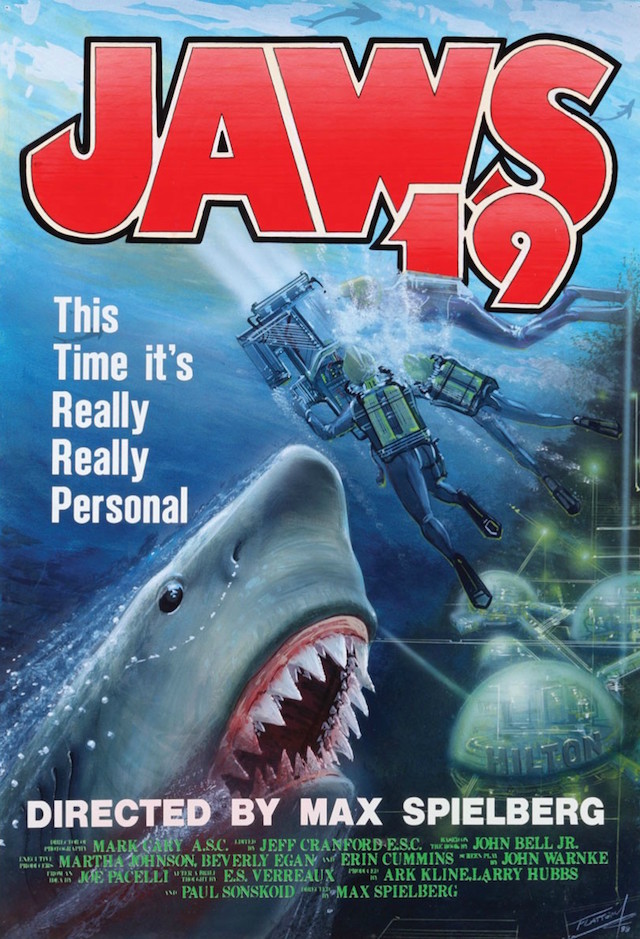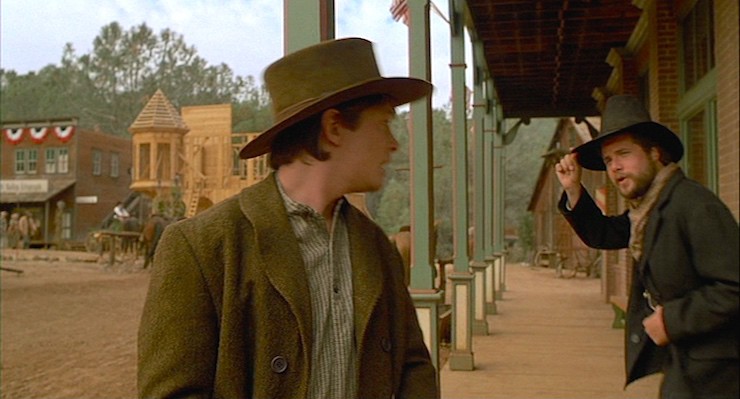The folks who created the Back to the Future movies want you to know: The future doesn’t stop here.
I started the day of October 21, 2015 in the most appropriate way possible: hoverboarding talking to Michael Klastorin, the unit publicist for Back to the Future Part II and III, and the co-author of new book Back to the Future: The Ultimate Visual History, as well as Bob Gale, the writer and co-creator of, you know, the entire series. Basically, I was talking to folks who knew everything there ever is to know about the movies, the world of Hill Valley, and the future. On the very same day that Marty, Doc, and Jennifer arrive into their “future.”
I see that your eyes have gone wide. Good. Keep them that way.
The Ultimate Visual History chronicles the extensive production process for the three movies, broken down into detail week by week, and supplemented by a tremendous amount of supporting visual material–initial script pages, concept drawings for the gadgets in the films, Bob Gale’s old yearbook, the never-before-seen letter that Marty left for Doc in 1955… There’s so much in the book that it literally can’t all fit on the page. Many of the items, like George and Lorraine’s prom photo or the poster for Jaws 19, are attached separately.
The book also makes you privy to the heavy-duty process that went into filming Back to the Future II and III back to back. Michael Klastorin’s role as the unit publicist on these two films put him in a central position between the requests from the media, the expectations of the fans, the demands of the studio, and the work of director Robert Zemeckis and his crew. Klastorin was there, in essence, to watch Back to the Future grow from a goofball surprise time travel hit, into a beloved touchstone of pop culture.
According to Klastorin, the crew spending the entirety of 1989 deep inside the world of Hill Valley played a large part on the ultimate the impact the trilogy had on the world. “I say in the book that I’m proud and honored to be in the Back to the Future family and that’s really what we became during our work on the sequels: a family. A part of my job was to keep folks away from the set, because we needed to focus on making these two films, these two very complex films.”
Klastorin and the production got a bit lucky in that creating their sci-fi epic in 1989 meant that the influence of the outside world was more centralized. “We didn’t have to deal with fans filming the set on their phones, or a hundred different outlets digging for information on the story. We didn’t have to deal with everyone knowing the budget for our movies beforehand, which was good. You never want a movie to be judged on those small pieces. You want the movie to be considered as itself.”
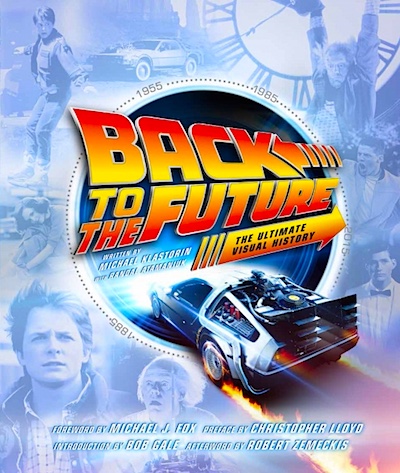 With outside influence turned away, the already vivid settings in Back to the Future Part II and III became reality for the cast and crew. Visual History details the intense amount of work that went into creating not one, but three different worlds for the characters to inhabit, all with their own separate challenges. “The pizza scene [in BttF II] in the McFly house took two whole days to shoot,” Klastorin reveals, referencing a scene where Michael J. Fox depicts Marty, Marty’s son, and Marty’s daughter all sitting down for a meal and interacting in one complex shot. Zemeckis and his crew had to invent an entirely new camera system, creating movable split screen technology years before CGI houses would perfect the same tech. Visual History also contains a three-week breakdown of how the hoverboard chase was created. (As well as some very, very spooky pictures where the hoverboards look like they’re actually hovering even when the cameras aren’t rolling.) Having to take so much time on just one-third of one of the movies required focus and dedication from every crew member. The separation from outside influence, the vivid worlds of Hill Valley in 2015, 1985, and 1955, and the focus from everyone on set created a familial, supportive atmosphere. It was them against the world. “It was hard work, yes,” Klastorin admits. “But it was such a great world to spend your time in!”
With outside influence turned away, the already vivid settings in Back to the Future Part II and III became reality for the cast and crew. Visual History details the intense amount of work that went into creating not one, but three different worlds for the characters to inhabit, all with their own separate challenges. “The pizza scene [in BttF II] in the McFly house took two whole days to shoot,” Klastorin reveals, referencing a scene where Michael J. Fox depicts Marty, Marty’s son, and Marty’s daughter all sitting down for a meal and interacting in one complex shot. Zemeckis and his crew had to invent an entirely new camera system, creating movable split screen technology years before CGI houses would perfect the same tech. Visual History also contains a three-week breakdown of how the hoverboard chase was created. (As well as some very, very spooky pictures where the hoverboards look like they’re actually hovering even when the cameras aren’t rolling.) Having to take so much time on just one-third of one of the movies required focus and dedication from every crew member. The separation from outside influence, the vivid worlds of Hill Valley in 2015, 1985, and 1955, and the focus from everyone on set created a familial, supportive atmosphere. It was them against the world. “It was hard work, yes,” Klastorin admits. “But it was such a great world to spend your time in!”
As filming continued on, the movies intruded more and more into the lives of the crew. “2015 was bright, but really challenging, so we didn’t get to appreciate it as much as you do when you’re watching the film,” Klastorin explains. “Then we moved into the alternate 1985, which we called ‘Biffhorrific’. The dark tone stayed with us as we were working on it, and [director] Bob Zemeckis says that because of that Part II is probably the darkest movie he’s ever done.”
A movie lasts only two to three hours, and can be shut off anytime, but the cast and crew of Back to the Future had to spend weeks inside Biffhorrific before moving on to the 1955 sequences of the film. In that kind of atmosphere, the BttF family had to squeeze in some fun where they could. Case in point: Lester: The Wallet Guy.
Personally, I have never, ever, forgotten this moment from Back to the Future Part II:
What’s the deal with that guy? For a moment, you think the movie actually might start following HIS adventures…
Writer Bob Gale explains: “The wallet gag was something Bob Z. came up with on the set to make that character memorable. Obviously, it worked!”
Wallet Guy obviously made a big impact on the crew, as well, even thirty-ish years later.”That actor has actually taken it out as a one-man show,” Klastorin jokes.
If only.
Random stress-relieving moments like The Wallet Guy were obviously required during the filming of Back to the Future Part II, and who knows what kind of non-sequiturs we might have gotten had the series not switched gears into the Old West in Back to the Future Part III?
In both the Visual History and Klastorin’s recollection, the western-themed Part III stands in great contrast with the creation of Part II. Although Part III took just as much, if not more, work to create than Part II (Part II could just redress the existing Hill Valley from Part I, but Part III had to build a whole new town.), the atmosphere was markedly different. “Part III was a great decompression after the filming of Part II because where Part II was hard, Part III was QUIET,” Klastorin reveals. “Part II was a closed set in Los Angeles with machinery and rigs and sixteen guys walking around with ladders.”
Part III, however, switched locations to dusty fields outside of Sonora, California, near Yosemite National Park, so far north that director Robert Zemeckis’s daily schedule involved flying between L.A. and Sonora on a daily basis so he could film Part III, then work on post-production for Part II. The majority of the cast and crew, however, essentially lived just outside the old West town they had created. “I mean, we didn’t build a hotel just off camera from old Hill Valley, but when you were there it was a much different place. There weren’t jets and trucks rolling by the time. You could only get to the set by walking there or taking a motorized cart. It was almost like actually going back to 1885.”
That sense of fun and camaraderie is clearly evident in the finished product, from Doc Brown’s gun-toting entrance to the clock tower dedication dance to the various and colorful townspeople of 1885 Hill Valley–a group that includes Klastorin himself! “I’m in there as Townsman #1!” Klastorin hails Marty, rather Mr. Eastwood, a good morning during the scene where Marty walks through town after having unwisely challenged Buford “Mad Dog” Tannen to a gunfight.
There was plenty for the Back to the Future family to do while they lived in the Old West. “Some of us would go horseback riding around the town on Sundays [the only days off that the shoot got] when the handlers took the horses out to be exercised.” The crew would also gather when new folks came to town, like legendary western actors Pat Buttram, Harey Carey Jr., Dub Taylor, and Matt Clark, who played the Hill Valley saloon bartender and the peanut gallery poker table. “It was so much fun to have old cowboys on the set! They’d be telling us all stories about their careers in between takes,” Klastorin says. “Sometimes at the same poker table they camp out at in the movie.”
Even the train itself in Back to the Future Part III carried movie history. “They loaded that train up with the entire crew and we would ride the rails for weeks! That particular train has a lot of movie history itself, been in dozens of movies starting from the silent era to today, like the Marx Bros’ Go West and some Buster Keaton movies.”
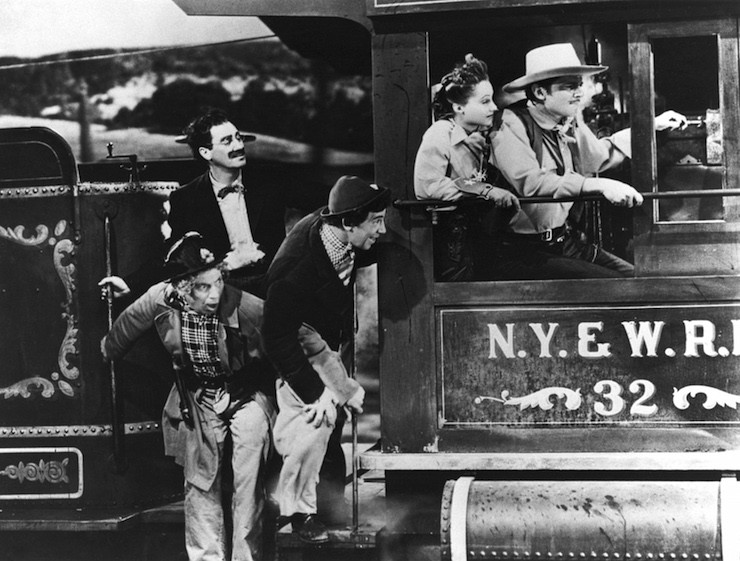
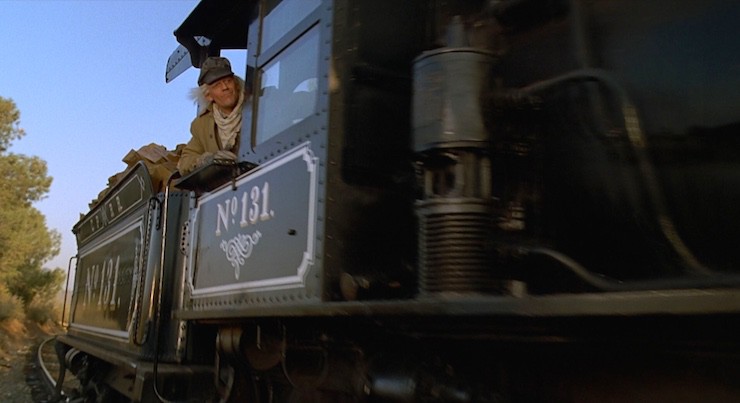
“And then you’d have ZZ Top come in and play concerts for us,” he continues, referencing the suspiciously familiar band visible during the clock tower dance scenes. “How can you not have an amazing time?”
After spending more than a year working alongside the same folks, experiencing the same surreal “outtatime” moments, it’s easy to see how Back to the Future turned from a movie trilogy into a formative familial experience for the crew. The tremendous box office debut of Back to the Future Part II further validated that experience, and the fans themselves would go on to sense the warmth and love put into the making of these movies. Some of us would be affected very deeply by them. The movies became pop culture, which became a continuum that carried us through the decades.
It’s a continuum that resulted in, amongst many things, Klastorin’s compilation of his time with the movies, as we can now see in Visual History. “You’ve been carrying this book inside your head for almost thirty years…” I told him.
“Yeah… We originally pitched this for the 25th anniversary, but it was supposed to happen now,” Klastorin laughs, telling me this on the morning of October 21, 2015. “This was the perfect time for the book.”
Back to the Future: The Ultimate Visual History really is a deep mining of the memories between Klastorin, co-author Randal Atamaniuk, and movie writer Bob Gale. Every false start, every failure, and every triumph of the films is chronicled within its colorful pages, to such an extent that it seems impossible that the first movie ever got made, let alone three monumental films. It also knows how to have fun with itself, as the movies themselves do. One of the props included is a lenticular photo of Marty and his siblings. Twist it one way and they disappear. Twist it back and they reappear. It’s so funny that it makes you want to do the same with your own family photos.
This article is being written mere hours before Marty and Doc “arrive” on the afternoon of October 21. So as you’re reading this, the entirety of the 130 year-spanning story of Back to the Future has finally become history. The future is now past, and once again unknowable.
And that’s great! As Klastorin, a person who has not just helped create Back to the Future, but very substantively lived Back to the Future, points out: “The positivity of the entire trilogy goes beyond the events in the movies. The future really is what you make of it. It’s up to you and the possibilities are endless. The future doesn’t stop at October 21, 2015!”
One Last Fan Theory…
Being a huge fan of Back to the Future and working at a science fiction publisher, I had to ask writer Bob Gale something I’ve been wondering about George McFly for a long time.
Did George McFly write episodes of the original series of Star Trek based on his encounter with Marty/Darth Vader in the first movie? In 1985, George and the McFly family are clearly is doing okay in terms of money, but he’s only just published his first novel, so where did that money come from? My (and Ryan Britt’s) theory: George wrote for television in the 60s, probably for Star Trek, and may have even created the planet “Vulcan” for the series.
Howsabout it, Bob?
George was likely a college professor of English or literature while he sold short stories and worked on his novel. He probably became head of the department at Hill Valley College and got tenure, allowing him to buy some nicer things for his family.
This also jives with the initial script for Back to the Future Part II, where Marty visits his parents in 1968 and George has become a professor.
So, George didn’t write any Star Trek, but Bob Gale very kindly tells me…
[George] probably assumed that Gene Roddenberry was visited by another alien from Planet Vulcan named Spock, and that inspired him to create Star Trek.
…and that’s just as awesome.
One Last LAST Fan Theory, I Promise…
I’m terrible, I know. The Visual History contains the mass market edition of George McFly’s book A Match Made in Space, which details the story of the book for the very first time. Bob Gale wrote the synopsis for that story and it is very clearly inspired by the events in Back to the Future Part I.
Since the events in the movie had such an impact on George, I asked Bob if he eventually recognizes that his son Marty is a time traveler.
A college aged George goes searching for Calvin Klein in issue #3 of IDW’s new comic series.
Looks like that issue just came out, too! At long last, the answer to my weird questions…
Chris Lough writes for Tor.com and is very, very happy with how he ended up spending October 21, 2015.











